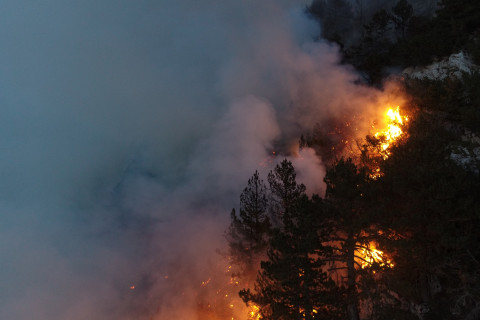The doctoral dissertation in the field of Biogeochemistry will be examined at the Faculty of Science, Forestry and Technology, Kuopio Campus.
What is the topic of your doctoral research? Why is it important to study the topic?
The topic of my doctoral research focuses on understanding the trends of biogenic volatile organic compound (BVOC) emissions from the forest floor in boreal forests, particularly in the context of wildfire disturbance and forest succession. BVOCs play a crucial role in atmospheric chemistry and climate dynamics, influencing processes such as ozone and aerosol formation, and thus have significant implications for air quality and climate change.
Studying BVOC emissions from the forest floor is essential for several reasons. First, the boreal forest biome is one of the largest terrestrial ecosystems globally and is a major source of BVOC emissions. The forest floor, comprising vegetation, litter, and soil organic matter, is a significant contributor to these emissions. Understanding the factors controlling BVOC emissions from the forest floor is therefore crucial for accurately modeling the regional BVOC budget and predicting their impacts on atmospheric chemistry and climate.
Second, wildfires are a common disturbance in boreal forests, and their frequency and intensity are expected to increase with climate change. Wildfires have profound effects on BVOC emissions from the forest floor, altering vegetation composition, soil properties, and microbial activity. Studying how wildfire disturbance influences BVOC emissions is important for assessing the feedback between wildfires and atmospheric chemistry, especially considering the potential for wildfires to exacerbate climate change through BVOC emissions.
Third, forest succession following wildfire disturbance also influences BVOC emissions from the forest floor. As forests recover from fire, changes in vegetation composition, soil properties, and microbial communities can affect BVOC production and release. Understanding how forest succession impacts BVOC emissions is critical for predicting long-term changes in atmospheric chemistry and climate dynamics in boreal regions.
Overall, studying BVOC emissions from the forest floor in boreal forests is important for advancing our understanding of ecosystem-environment interactions, especially in the context of climate change and increasing wildfire frequency. By elucidating the factors controlling BVOC emissions and their responses to disturbance and succession, my research contributes to improving predictive models of atmospheric chemistry and climate dynamics, ultimately informing strategies for mitigating climate change and managing forest ecosystems effectively.
What are the key findings or observations of your doctoral research?
The key findings of my doctoral research revolve around two main themes: the characterization of biogenic volatile organic compound (BVOC) emissions from boreal forest floors and the assessment of extreme fire risks in Finnish boreal forests.
Firstly, the research demonstrates that the forest floor serves as a significant source of diverse BVOCs, with monoterpene (MT) emissions being the largest group observed. BVOC emissions varied across different-aged forest areas, with declines noted in recently burned forests due to reduced ground vegetation coverage and soil organic matter decomposition. Conversely, emissions increased as aboveground vegetation recovered and soil organic matter accumulated. Ground vegetation composition, soil moisture, and air temperature were identified as key factors influencing BVOC emissions, with their effects varying across different forest age classes.
Secondly, the study assesses the risk of extreme fires in Finnish boreal forests, revealing an increasing trend in the annual probability of extreme fire risk over the past seven decades. Model simulations suggest this trend will continue, especially under the RCP8.5 climate scenario. Seasonally, early spring and autumn are projected to experience significant increases in extreme fire risks, while summer trends remain relatively stable.
The implementation of this research and its findings offers several valuable contributions to both the scientific community and the general public. Firstly, it enhances our understanding of BVOC emissions from boreal forest floors, shedding light on the complex interactions between vegetation, soil, and environmental factors. This knowledge can inform future studies on atmospheric chemistry, ecosystem dynamics, and climate modeling, contributing to broader discussions on global carbon budgets and climate change mitigation strategies.
Additionally, the assessment of extreme fire risks in Finnish boreal forests provides crucial insights for policymakers, land managers, and stakeholders involved in fire prevention and management efforts. By identifying trends and potential future scenarios, this research helps guide the development of effective wildfire prevention measures, land-use planning strategies, and emergency response protocols. Moreover, raising awareness about the increasing risk of extreme wildfires underscores the importance of proactive measures to mitigate their environmental, economic, and social impacts.
Overall, the research presented in this doctoral dissertation advances our understanding of BVOC emissions from boreal forest floors and enhances our ability to assess and manage the risk of extreme wildfires in Finnish boreal forests. By addressing these critical environmental challenges, the findings contribute to broader efforts aimed at promoting ecosystem resilience, preserving biodiversity, and safeguarding the well-being of both natural and human communities in boreal regions worldwide.
How can the results of your doctoral research be utilised in practice?
The results of my doctoral research have several practical implications across various domains, including ecosystem management, climate change mitigation, and wildfire risk assessment and management.
Firstly, the findings regarding biogenic volatile organic compound (BVOC) emissions from the forest floor provide valuable insights for ecosystem management and air quality monitoring. Understanding the factors influencing BVOC emissions, such as vegetation composition, soil moisture, and temperature, can aid in predicting and managing air quality and atmospheric chemistry in boreal forest ecosystems. This knowledge can inform forest management practices aimed at preserving air quality and mitigating the impact of BVOC emissions on atmospheric processes.
Secondly, the assessment of extreme wildfire risks in Finnish boreal forests offers crucial information for wildfire risk assessment and management strategies. The observed increasing trends in extreme fire risks over the past decades and projected future increases underscore the urgency of implementing effective fire prevention measures and adaptive strategies. Stakeholders involved in forest management, land use planning, and emergency response can use this information to prioritize resources, develop mitigation strategies, and enhance preparedness for extreme wildfire events.
Additionally, the identification of environmental and biotic factors influencing BVOC emissions and wildfire risks can inform land use planning and policy decisions. Incorporating this knowledge into land management practices can help minimize the risk of wildfires, preserve biodiversity, and promote sustainable forest management practices.
Furthermore, the research outcomes contribute to the scientific understanding of boreal forest ecosystems and their response to environmental changes, particularly in the context of climate change and wildfire dynamics. This knowledge can support evidence-based decision-making and policy development aimed at addressing climate change impacts and enhancing ecosystem resilience.
In summary, the results of my doctoral research provide valuable insights and practical guidance for ecosystem management, air quality monitoring, climate change mitigation, and wildfire risk assessment and management. By translating these research findings into actionable strategies and policies, stakeholders can work towards promoting the sustainable management and conservation of boreal forest ecosystems while mitigating the impacts of climate change and extreme wildfire events.
What are the key research methods and materials used in your doctoral research?
The doctoral research focused on quantifying and characterizing biogenic volatile organic compound (BVOC) emissions from the forest floor in boreal forests and assessing the risk of extreme wildfires in Finland. To achieve these objectives, field measurement campaigns were conducted across different-aged forest areas in central Siberia, Russia, Finnish Lapland, and Inuvik, Canada. The Canadian Forest Fire Weather Index (FWI) System was utilized to evaluate extreme fire risks using historical climate data (1951-2020) and future climate data (2020-2099) under three Representative Concentration Pathway (RCP) scenarios. Key research methods included:
Field Measurements: BVOC emissions were quantified using field measurement campaigns conducted across forest areas of varying ages after wildfires. These measurements provided insights into the composition and magnitude of BVOC emissions from the forest floor.
Statistical Analysis: ANOVA, linear regressions, principle component analysis, partial least square regression and path modeling were employed to investigate the influence of abiotic (e.g., air temperature, soil moisture, light intensity) and biotic factors (ground vegetation characteristics, soil respiration rates, microbial biomass) on BVOC emissions at different forest development stages.
Climate Modeling: Climate model simulations were used to assess the risk of extreme wildfires in Finland under current and future climatic conditions. The FWI was calculated using historical climate data and outputs from regional climate models representing different RCP scenarios.
Overall, the research involved a multidisciplinary approach combining field measurements, statistical analysis, and climate modeling to gain insights into BVOC emissions from the forest floor and the risk of extreme wildfires in boreal forests. These findings contribute to a better understanding of the interactions between wildfires, BVOC emissions, and climate change, and provide valuable information for fire management and prevention strategies in boreal regions.
The doctoral dissertation of Huizhong Zhang-Turpeinen, MSc, entitled Biogenic volatile organic compound emissions from the boreal forest floor after wildfire will be examined at the Faculty of Science, Forestry and Technology, Kuopio Campus. The opponent will be Professor Steffen Manfred Noe, Estonian University of Life Sciences, and the custos will be Professor Jukka Pumpanen, University of Eastern Finland. Language of the public defence is English.
For more information, please contact:
Huizhong Zhang-Turpeinen, [email protected], p. 050 324 7529




